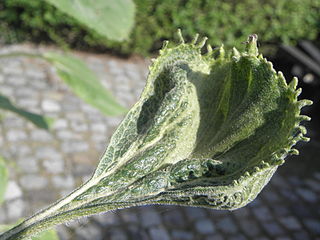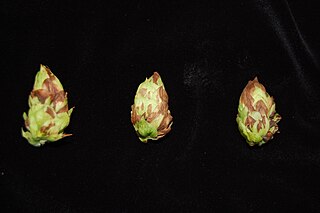
Downy mildew refers to any of several types of oomycete microbes that are obligate parasites of plants. Downy mildews exclusively belong to the Peronosporaceae family. In commercial agriculture, they are a particular problem for growers of crucifers, grapes and vegetables that grow on vines. The prime example is Peronospora farinosa featured in NCBI-Taxonomy and HYP3. This pathogen does not produce survival structures in the northern states of the United States, and overwinters as live mildew colonies in Gulf Coast states. It progresses northward with cucurbit production each spring. Yield loss associated with downy mildew is most likely related to soft rots that occur after plant canopies collapse and sunburn occurs on fruit. Cucurbit downy mildew only affects leaves of cucurbit plants.
Phytophthora sojae is an oomycete and a soil-borne plant pathogen that causes stem and root rot of soybean. This is a prevalent disease in most soybean growing regions, and a major cause of crop loss. In wet conditions the pathogen produces zoospores that move in water and are attracted to soybean roots. Zoospores can attach to roots, germinate, and infect the plant tissues. Diseased roots develop lesions that may spread up the stem and eventually kill the entire plant. Phytophthora sojae also produces oospores that can remain dormant in the soil over the winter, or longer, and germinate when conditions are favourable. Oospores may also be spread by animals or machinery.

Phytophthora medicaginis is an oomycete plant pathogen that causes root rot in alfalfa and chickpea. It is a major disease of these plants and is found wherever they are grown. P. medicaginis causes failure of stand establishment because of seedling death. Phytophthora medicaginis is part of a species complex with Phytophthora megasperma.
Pythium irregulare is a soil borne oomycete plant pathogen. Oomycetes, also known as "water molds", are fungal-like protists. They are fungal-like because of their similar life cycles, but differ in that the resting stage is diploid, they have coenocytic hyphae, a larger genome, cellulose in their cell walls instead of chitin, and contain zoospores and oospores.
Pythium ultimum is a plant pathogen. It causes damping off and root rot diseases of hundreds of diverse plant hosts including corn, soybean, potato, wheat, fir, and many ornamental species. P. ultimum belongs to the peronosporalean lineage of oomycetes, along with other important plant pathogens such as Phytophthora spp. and many genera of downy mildews. P. ultimum is a frequent inhabitant of fields, freshwater ponds, and decomposing vegetation in most areas of the world. Contributing to the widespread distribution and persistence of P. ultimum is its ability to grow saprotrophically in soil and plant residue. This trait is also exhibited by most Pythium spp. but not by the related Phytophthora spp., which can only colonize living plant hosts.
Sclerophthora macrospora is a protist plant pathogen of the class Oomycota. It causes downy mildew on a vast number of cereal crops including oats, rice, maize, and wheat as well as varieties of turf grass. The common names of the diseases associated with Sclerophthora macrospora include "crazy top disease" on maize and yellow tuft disease on turf grass. The disease is present all over the world, but it is especially persistent in Europe.

Podosphaera macularis is a plant pathogen infecting several hosts including chamomile, caneberrie, strawberries, hop, hemp and Cineraria. It causes powdery mildew of hops.

Albugo is a genus of plant-parasitic oomycetes. Those are not true fungi (Eumycota), although many discussions of this organism still treat it as a fungus. The taxonomy of this genus is incomplete, but several species are plant pathogens. Albugo is one of three genera currently described in the family Albuginaceae, the taxonomy of many species is still in flux.
Pseudocercospora cannabina is a fungal plant pathogen infecting hemp. Cercospora cannabina was originally found on the leaves of Cannabis sativa in Uganda. Then in 1976, it was renamed as Pseudocercospora cannabina by mycologist Frederick Claude Deighton (1903-1992).

Bremia lactucae is a plant pathogen. This microorganism causes a disease of lettuce denominated as downy mildew. Some other strains can be found on 36 genera of Asteraceae including Senecio and Sonchus. Experiments using sporangia from hosts do not infect lettuce and it is concluded that the fungus exists as a quantity of host-specific strains. Wild species, such as Lactuca serriola, or varieties of Lactuca can hold strains that infect lettuce, but these pathogens are not sufficiently common to seriously infect the plant.

Peronospora manshurica is a plant pathogen. It is a widespread disease on the leaves of soybeans and other crop plants. The fungi is commonly referred to as downy mildew, "leafspot", or "leaf-spot".

Plasmopara halstedii is a plant pathogen infecting sunflowers. The species is one of many pathogens commonly referred to as downy mildew. P. halstedii originated in North America.

Plasmopara viticola, the causal agent of grapevine downy mildew, is a heterothallic oomycete that overwinters as oospores in leaf litter and soil. In the spring, oospores germinate to produce macrosporangia, which under wet condition release zoospores. Zoospores are splashed by rain into the canopy, where they swim to and infect through stomata. After 7–10 days, yellow lesions appear on foliage. During favorable weather the lesions sporulate and new secondary infections occur.

Pseudoperonospora humuli is a plant pathogen that causes downy mildew on hops.
Peronosclerospora sorghi is a plant pathogen. It is the causal agent of sorghum downy mildew. The pathogen is a fungal-like protist in the oomycota, or water mold, class. Peronosclerospora sorghi infects susceptible plants though sexual oospores, which survive in the soil, and asexual sporangia which are disseminated by wind. Symptoms of sorghum downy mildew include chlorosis, shredding of leaves, and death. Peronosclerospora sorghi infects maize and sorghum around the world, but causes the most severe yield reductions in Africa. The disease is controlled mainly through genetic resistance, chemical control, crop rotation, and strategic timing of planting.

Pseudoperonospora cubensis is a species of water mould known for causing downy mildew on cucurbits such as cantaloupe, cucumber, pumpkin, squash and watermelon. This water mould is an important pathogen of all these crops, especially in areas with high humidity and rainfall, such as the eastern United States. In most years the disease is an annual, late-season problem on squash and pumpkin in the eastern and central United States, however, since 2004 it has become one of the most important diseases in cucumber production. Considered a highly destructive foliar disease of cucurbits, successful breeding in the mid-twentieth century provided adequate control of downy mildew in cucumber without the use of fungicides. The resurgence in virulence has caused growers great concern and substantial economic losses, while downy mildew in other cucurbit crops continues to be a yearly hindrance.

Peronospora destructor is a plant pathogen. It causes downy mildew on leaves of cultivated and wild Allium. Allium cepa is most often affected, while Allium schoenoprasum (chives) and Allium porrum (leek) are only occasionally affected.
Buckeye rot of tomato is caused by three species of pathogens in the genus Phytophthora: P. nicotianae var. parasitica, P. capsici, and P. drechsleri. It is an oomycete that thrives in warm, wet conditions and lives in the soil. It is characterized by a bull’s eye pattern of dark brown rotting on the tomato fruit, and affects fruit that is close to, or lying on the soil. The easiest management is to keep the plant out of contact with the soil, although other chemical methods can be very effective. This disease commonly occurs in the southeast and south central areas of the United States. The disease has affected a large portion of crop yield in the United States as well as India. The relatively small genome size of Phytophthora parasitica compared to Phytophthora infestans gives researchers the unique ability to further examine its ability to cause disease.
Black rot on orchids is caused by Pythium and Phytophthora species. Black rot targets a variety of orchids but Cattleya orchids are especially susceptible. Pythium ultimum and Phytophthora cactorum are known to cause black rot in orchids.










